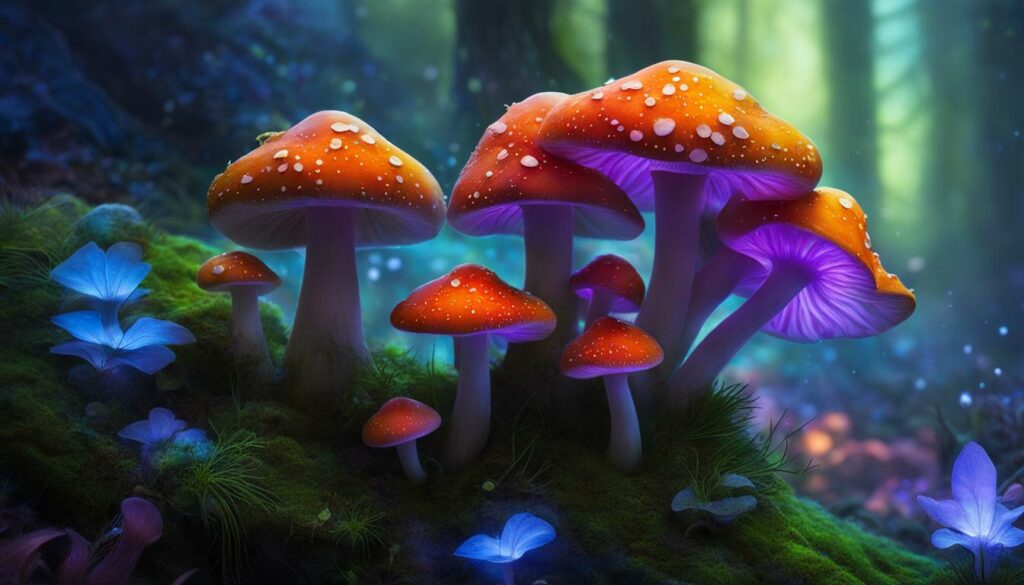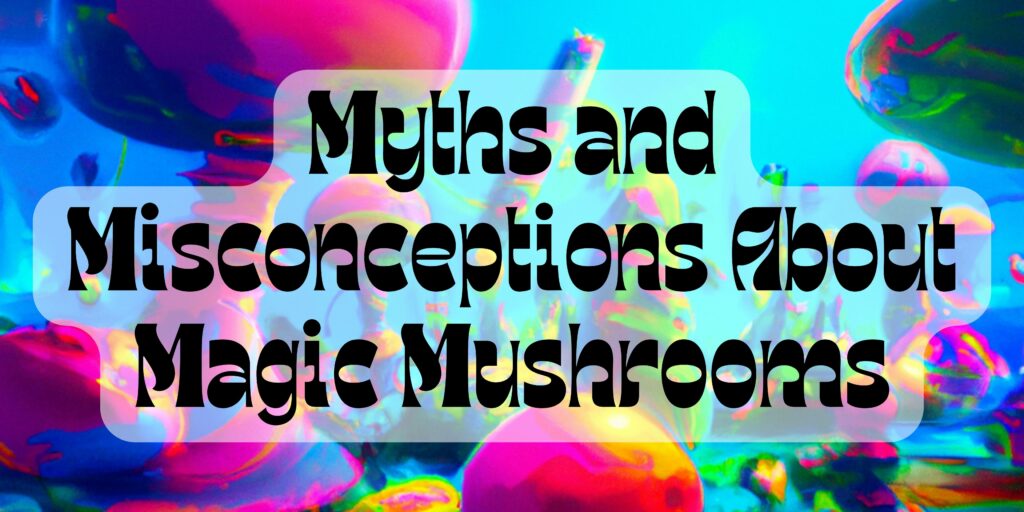Curious about the enigmatic effects of shrooms? Prepare to be astonished as we dive into the captivating world of psilocybin mushrooms. These extraordinary fungi have been revered for their mind-altering properties for centuries. But have you ever wondered how shrooms actually work in the human body? Let’s unravel the mystery and explore the psychedelic wonders of psilocybin.
Key Takeaways:
- Psilocybin mushrooms contain the psychedelic compound psilocybin, which is converted into psilocin in the body.
- Psilocin interacts with serotonin receptors in the brain, leading to alterations in perception, mood, and cognition.
- Research suggests that psilocybin can activate specific cortical signaling pathways and decrease activity in “hub” regions of the brain.
- The psychological impact of shrooms can vary, but commonly includes visual hallucinations, changes in perception of time and space, and altered mood.
- Shrooms and psilocybin are being explored as potential therapeutic tools for mental health conditions, such as depression and anxiety.
The Neurochemical Processes Behind Shroom Trips
Understanding the neurochemical processes behind the psychedelic effects of shrooms is key to unraveling their mysterious capabilities. Psilocybin, the active compound in magic mushrooms, interacts with serotonin receptors in the brain, particularly the 5-HT2A receptor. This interaction triggers a chain of events that result in altered neural activity and increased communication between different brain regions.
When ingested, psilocybin is metabolized by the liver into psilocin, the compound responsible for the psychedelic effects of shrooms. Psilocin then crosses the blood-brain barrier and binds to serotonin receptors, leading to an array of psychological and perceptual changes. The activation of these receptors and the subsequent alteration in neural activity contribute to the unique experiences associated with shroom trips.
“Psilocybin interacts with serotonin receptors in the brain, leading to altered neural activity and increased communication between different brain regions.”
This complex interaction between psilocybin and serotonin receptors plays a pivotal role in shaping the profound effects of shrooms on the human mind. By understanding these neurochemical processes, researchers are gaining valuable insights into the therapeutic potential of psilocybin-assisted therapy and its potential to treat mental health conditions such as depression and anxiety.
Table: Neurochemical Processes in Shroom Trips
| Neurochemical Process | Explanation |
|---|---|
| Psilocybin Metabolism | Psilocybin is metabolized into psilocin by the liver, which then crosses the blood-brain barrier. |
| Serotonin Receptor Activation | Psilocin binds to serotonin receptors, particularly the 5-HT2A receptor, leading to altered neural activity. |
| Increased Neural Communication | Activation of serotonin receptors enhances communication between different brain regions. |
While much is still unknown about the intricacies of these neurochemical processes, ongoing research is shedding light on the potential therapeutic applications of shrooms and the mechanisms through which they exert their effects on the brain.
Exploring the Psychological Impact of Shrooms
Magic mushrooms, also known as shrooms, have long been recognized for their hallucinogenic properties. When consumed, these fungi can induce a range of psychological effects that vary from person to person. Some individuals may experience vivid visual hallucinations, while others may undergo profound changes in their perception of time and space. Additionally, shrooms can alter mood and emotions, leading to a heightened sense of introspection and spirituality.
Research has shown that the psychological impact of shrooms can extend beyond the immediate trip. Many individuals report having deeply meaningful experiences and gaining valuable insights into themselves and their lives. These transformative encounters can have a lasting impact on their mental well-being and outlook. As a result, there is growing interest in the therapeutic potential of psilocybin, the active compound in shrooms, for the treatment of mental health disorders.
Studies have indicated that psilocybin-assisted therapy may be effective in alleviating symptoms of depression, anxiety, and other psychiatric conditions. The unique psychological effects induced by shrooms, such as increased openness, introspection, and enhanced emotional processing, can contribute to the therapeutic benefits. By facilitating a deeper exploration of one’s thoughts, feelings, and experiences, psilocybin therapy offers a promising alternative to traditional treatment approaches.
| Psychological Effects of Shrooms | Potential Therapeutic Applications |
|---|---|
| Visual hallucinations | Depression |
| Altered perception of time and space | Anxiety |
| Enhanced introspection and spirituality | Post-traumatic stress disorder (PTSD) |
| Improved mood and emotional processing | Substance use disorders |
While the therapeutic potential of shrooms is promising, further research is needed to fully understand the mechanisms and optimize treatment protocols. It is essential to ensure safe and controlled environments for psilocybin therapy, as set and setting play crucial roles in shaping the overall experience and outcomes. By continuing to explore the psychological impact of shrooms and their therapeutic applications, we can unlock new avenues for mental health treatment and potentially provide relief to those in need.
Unraveling the Effects on the Brain through Brain Scans
Brain scans have played a crucial role in understanding the effects of psilocybin on the brain. These scans provide valuable insights into how the compound alters brain activity, connectivity, and the retrieval of memories. Understanding these effects is essential for unraveling the mechanisms behind the therapeutic potential of shrooms.
One significant finding from brain scans of individuals under the influence of psilocybin is the decreased activity in “hub” regions of the brain. These regions, known for their high connectivity with other brain areas, are thought to be involved in various cognitive processes. By suppressing activity in these hub regions, psilocybin may disrupt the normal functioning of the brain and lead to the unique psychological experiences associated with shroom trips.
“Brain scans have shown that psilocybin enhances the recollection of personal memories and improves connectivity between brain regions involved in sensory processing.”
Furthermore, brain scans have revealed that psilocybin can enhance the recollection of personal memories. This suggests that shrooms have the potential to facilitate access to emotional and autobiographical memories, potentially contributing to the profound personal insights experienced during a psychedelic trip. Additionally, psilocybin has been found to improve connectivity between brain regions involved in sensory processing, which may explain the altered perception and sensory experiences reported by individuals under the influence of shrooms.
Table: Effects of Psilocybin on Brain Activity and Connectivity
| Effects | Description |
|---|---|
| Decreased activity in “hub” regions | Psilocybin reduces activity in highly connected brain regions, leading to altered cognitive functioning. |
| Enhanced recollection of personal memories | Psilocybin facilitates access to emotional and autobiographical memories, leading to profound personal insights. |
| Improved connectivity between sensory processing regions | Psilocybin enhances communication between brain regions involved in sensory processing, resulting in altered perception and sensory experiences. |
Through brain scans, scientists are beginning to uncover the intricate ways in which psilocybin influences the brain. These findings help shed light on the unique psychological effects of shrooms and contribute to our understanding of their therapeutic potential. However, further research is still needed to fully comprehend the long-term effects and mechanisms of action of psilocybin on brain activity and connectivity.
The Potential Therapeutic Applications of Shrooms
Shrooms, also known as psilocybin mushrooms, are being increasingly recognized for their potential therapeutic applications in treating mental health conditions such as depression and anxiety. This psychedelic substance has shown promising results in clinical trials, offering a novel approach to mental health treatment.
Research has demonstrated that shrooms have the ability to significantly reduce depressive symptoms and improve emotional well-being. In a study published in the Journal of Psychopharmacology, researchers found that a single dose of psilocybin led to a significant decrease in depression and anxiety scores in patients with treatment-resistant depression. The effects were sustained for up to six months, highlighting the long-lasting potential of psychedelic-assisted therapy.
Psilocybin therapy works differently from traditional antidepressants by promoting a more flexible and fluid brain state. It facilitates introspection and enhances emotional processing, allowing individuals to gain new perspectives on their thoughts and emotions. This unique therapeutic approach has garnered interest from mental health professionals and researchers alike, who are eager to explore its potential in treating a range of mental illnesses, including anorexia and addiction.
| Condition | Treatment | Results |
|---|---|---|
| Depression | Psilocybin-assisted therapy | Significant reduction in depressive symptoms, sustained effects up to six months |
| Anxiety | Psilocybin therapy | Improved emotional well-being, decreased anxiety scores |
| Substance addiction | Psilocybin-assisted therapy | Preliminary studies show potential for reducing addiction severity |
While psilocybin therapy holds promise, further research is needed to fully understand its mechanisms and long-term effects. Despite legal and regulatory challenges, ongoing studies and clinical trials are advancing our understanding of shrooms’ therapeutic potential. As the medical community continues to explore new avenues for mental health treatment, it is clear that shrooms could emerge as a valuable alternative for individuals seeking relief from depression, anxiety, and other psychiatric disorders.
Conclusion
Psilocybin therapy shows great potential as a alternative approach to traditional treatments for mental health disorders. The complex impact of psilocybin on the brain, influencing neural activity, connectivity, and emotional processing, suggests its ability to promote brain flexibility and improve mental health outcomes.
Research has shown promising results in reducing depressive symptoms and improving emotional wellbeing, particularly when psilocybin therapy is used in conjunction with therapy. This emerging field of study offers a potential alternative for those seeking new solutions to mental health challenges.
While further research is needed to fully understand the mechanisms and long-term effects of psilocybin therapy, its therapeutic potential cannot be overlooked. By exploring the benefits of psilocybin therapy, such as improved brain connectivity and mental health outcomes, we can open up new avenues of treatment for those in need.
FAQ
How do shrooms work in the human body?
Psilocybin mushrooms, commonly known as magic mushrooms, contain the psychedelic compound psilocybin. When ingested, psilocybin is converted into psilocin, which interacts with serotonin receptors in the brain. This interaction leads to a variety of psychedelic effects, including alterations in perception, mood, and cognition.
What are the neurochemical processes behind shroom trips?
Psilocybin binds to serotonin receptors, specifically the 5-HT2A receptor, in the brain. This activation of serotonin receptors leads to changes in neural activity and increased communication between brain regions. Psilocybin is metabolized into psilocin by the liver, which then crosses the blood-brain barrier and interacts with serotonin receptors. These neurochemical processes play a crucial role in shaping the psychedelic effects of shrooms.
What is the psychological impact of shrooms?
The psychological impact of shrooms can vary widely depending on the individual and dosage. Common effects include visual hallucinations, changes in perception of time and space, and altered mood. These hallucinogenic properties can lead to profound personal insights, spiritual experiences, and even therapeutic benefits.
How do shrooms affect the brain according to brain scans?
Brain scans of individuals under the influence of psilocybin have shown decreased activity in “hub” regions of the brain, which are highly connected with other areas. Psilocybin has also been found to enhance the recollection of personal memories and improve connectivity between brain regions involved in sensory processing.
What are the potential therapeutic applications of shrooms?
Shrooms and psilocybin are being explored as potential treatments for various mental health conditions, including depression and anxiety. Research suggests that psilocybin therapy can be effective in reducing depressive symptoms and improving emotional well-being. It is also being investigated as a therapeutic tool for anorexia and addiction.
What makes shrooms a potential alternative for mental health treatment?
Psilocybin, the active compound in magic mushrooms, has a complex impact on the brain, affecting neural activity, connectivity, and emotional processing. Research suggests that it can promote brain flexibility and improve mental health outcomes, particularly when used in conjunction with therapy.




